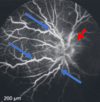Tertiary Syphilis-Induced Ocular Syphilis Complicated by Retinal Detachment
- PMID: 40291298
- PMCID: PMC12028062
- DOI: 10.7759/cureus.81240
Tertiary Syphilis-Induced Ocular Syphilis Complicated by Retinal Detachment
Abstract
Tertiary syphilis can cause eye diseases such as ocular syphilis and retinal detachment. Herein, we present a case of a 28-year-old male with no reported past medical history. He presented to the emergency department with complaints of pain, blurriness, and vision loss in his left eye, leading to a fall during a recent ophthalmologist visit. Diagnosis typically relies on detailed clinical examination, lumbar punctures, and serological testing to diagnose and manage the patient's condition. The results of these tests led to the diagnosis of tertiary syphilis-induced ocular syphilis complicated by retinal detachment, which was treated with penicillin G intravenously (IV) daily. The patient was transferred to a long-term acute care facility with an ophthalmologist follow-up post-admission. This case highlights the importance of recognizing and emphasizing timely diagnosis of ocular syphilis and proper disease management as a crucial factor in preventing permanent vision loss.
Keywords: ocular syphilis; retinal detachment; syphilis; tertiary syphilis; vision loss.
Copyright © 2025, Khan et al.
Conflict of interest statement
Human subjects: Consent for treatment and open access publication was obtained or waived by all participants in this study. Edward Via College of Osteopathic Medicine Institutional Review Board issued approval 2024-188. Conflicts of interest: In compliance with the ICMJE uniform disclosure form, all authors declare the following: Payment/services info: All authors have declared that no financial support was received from any organization for the submitted work. Financial relationships: All authors have declared that they have no financial relationships at present or within the previous three years with any organizations that might have an interest in the submitted work. Other relationships: All authors have declared that there are no other relationships or activities that could appear to have influenced the submitted work.
Figures


Similar articles
-
Eyes As the Window to Syphilis: A Rare Case of Ocular Syphilis As the Initial Presentation of Syphilis.Cureus. 2020 Feb 14;12(2):e6998. doi: 10.7759/cureus.6998. Cureus. 2020. PMID: 32206462 Free PMC article.
-
Acute vision changes as the presenting symptom of ocular syphilis - A case series of two.IDCases. 2024 Aug 2;37:e02037. doi: 10.1016/j.idcr.2024.e02037. eCollection 2024. IDCases. 2024. PMID: 39193406 Free PMC article.
-
Nongranulomatous Uveitis as the First Manifestation of Syphilis.Optom Vis Sci. 2016 Jun;93(6):647-51. doi: 10.1097/OPX.0000000000000838. Optom Vis Sci. 2016. PMID: 26927522
-
Role Of Point Of Care Ultrasound In The Diagnosis Of Retinal Detachment In The Emergency Department.Open Access Emerg Med. 2019 Nov 13;11:265-270. doi: 10.2147/OAEM.S219333. eCollection 2019. Open Access Emerg Med. 2019. PMID: 32009820 Free PMC article. Review.
-
The many faces of ocular syphilis: case-based update on recognition, diagnosis, and treatment.Can J Ophthalmol. 2021 Oct;56(5):283-293. doi: 10.1016/j.jcjo.2021.01.006. Epub 2021 Feb 4. Can J Ophthalmol. 2021. PMID: 33549544 Review.
References
-
- Tudor ME, Al Aboud AM, Leslie SW, Gossman W. Treasure Island (FL): StatPearls Publishing; 2024. Syphilis.
-
- Risk factors for early syphilis among gay and bisexual men seen in an STD clinic: San Francisco, 2002-2003. Wong W, Chaw JK, Kent CK, Klausner JD. Sex Transm Dis. 2005;32:458–463. - PubMed
Publication types
LinkOut - more resources
Full Text Sources
Miscellaneous
